Menu
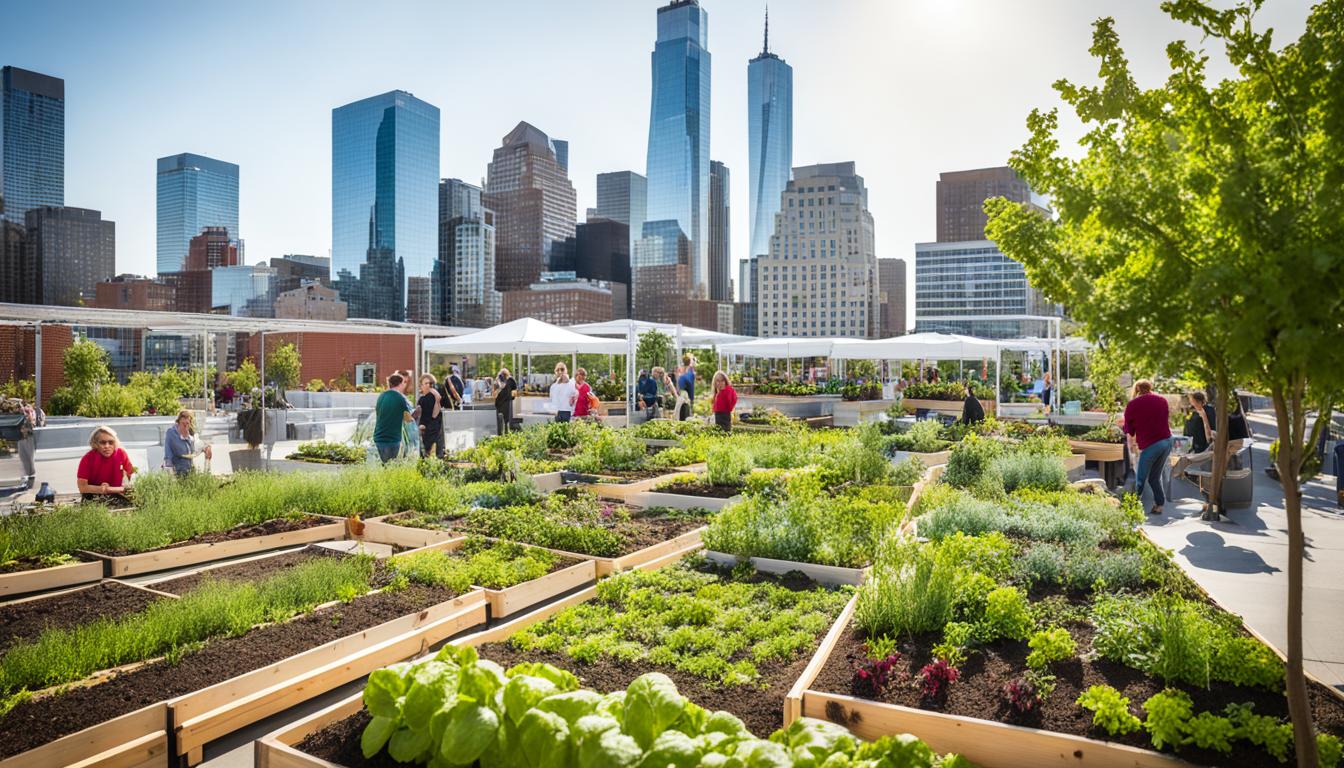
Did you know the United Nations predicts nearly ten billion people will live in cities by 2050? This means we need creative urban agriculture solutions fast. Urban agriculture isn’t just a trend; it’s vital for sustainable city growth. Cities will likely have 6.68 billion residents by 2050. With such a huge increase, we must quickly change how we grow our food.
Urban farming projects promise to tackle many urban issues at once. They help with climate change, include more people, reduce poverty, and manage water better. CultiCiudad in Mexico City and City Growers in New York show the big wins from urban farming. Henk de Zeeuw, from the RUAF Foundation, says mixing farming and forestry in cities boosts both nature and the community.
Urban agriculture is growing fast, catching the eye of many. It’s becoming key for cities looking to fight climate change and make sure there is enough food. It brings cities closer to where their food comes from, aiming to provide food sources that are sustainable and easy to reach.
Urban agriculture covers many activities, bringing food growth and distribution into city areas. It involves projects like community gardens, indoor farms using technology, and businesses that grow food in the city. The U.S. Department of Agriculture points out four main types of urban farming: community gardens, community farms, commercial farms, and institutional farms. They all help cities in different ways, from growing unique foods to having educational projects in places like schools and hospitals.
Urban agriculture is a big deal for cities today. It helps them become more sustainable and fair. While traditional farming makes changes, urban farming uses advanced methods like growing crops without soil. Such methods help commercial urban farms make money from special crops.
In the past, during World War II, victory gardens showed how important city farming is. Today, community gardens, often run by volunteers, bring communities together and offer social benefits. They’re a crucial part of city farming, getting people involved and bringing positive changes to communities.
Projects like community gardens do more than produce food locally. They get people engaged and offer big advantages for the environment. With almost 68% of us living in cities by 2050, such efforts will be crucial. They’ll help ensure there’s enough food and push for healthier, sustainable living in urban areas.
Urban farming helps cities deal with food insecurity and supports sustainable living. It has a big economic, social, and green benefit. Working together, these areas make cities more lively and self-sufficient.
Urban farming brings in money by creating jobs and supporting local businesses. It offers work in agriculture and boosts related companies like those that sell farming tools. It also helps cities spend less on importing food, keeping money local.
Urban farming brings people together. It encourages folks to work and learn from each other. Workshops and school activities teach about sustainable living, making communities stronger. People feel proud and connected, building a better community spirit.
Urban farming is great for the environment. It uses smart farming and water-saving tech. This helps Garden eat up the heat in the city and cuts down on harmful gases from food transportation. It also makes compost, lowering trash and helping our cities stay clean.
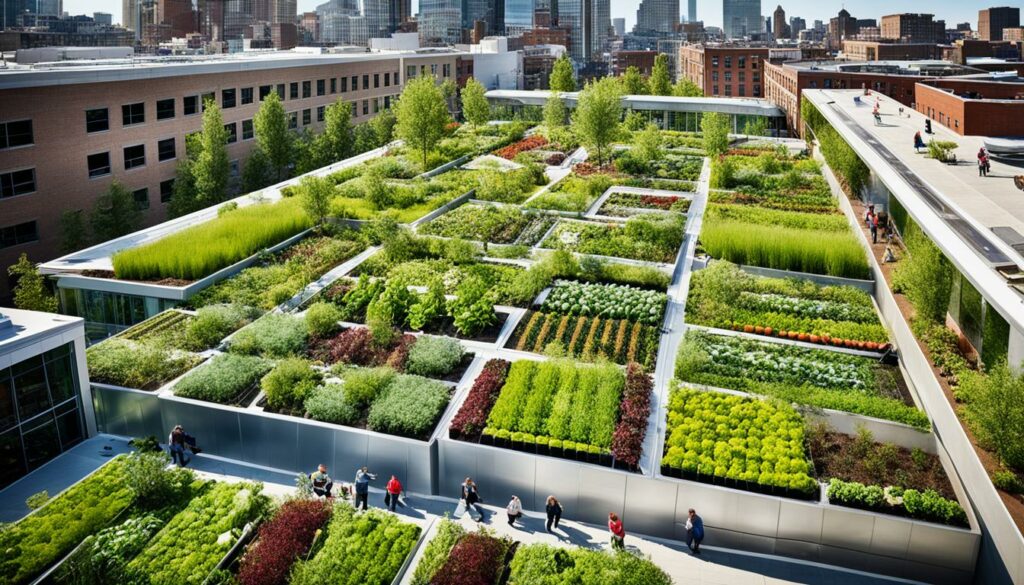
As cities get bigger, these farming projects are vital. They make cities safer and greener. They also help people live better lives.
| Benefit | Impact |
|---|---|
| Economic Growth | Job creation, local economic support, cost savings |
| Community Engagement | Enhanced social bonds, educational opportunities, neighbourhood pride |
| Environmental Sustainability | Water conservation, biodiversity, reduced greenhouse gases |
I’ve looked at some key examples to show how sustainable city farming works. These cases show different methods and how they help cities grow their own food.
AeroFarms in Newark has led the way in urban farming with its use of aeroponics. It grows plants in a mist, using almost no water compared to traditional methods. This way, they produce more food and do it all year, no matter the season. AeroFarms shows us how to farm in cities smartly, making the most of resources and food.
Gotham Greens is another top project found in different US cities. They use climate-controlled greenhouses that run on renewable power. This helps their plants grow well and local areas get fresh food with less transport harm. Gotham Greens points to a future where cities farm more, pollute less, and eat better.
Agricool, in Paris, does things differently by growing strawberries in city containers. These units use clean energy and take up little space. They blend in with the city while providing fresh food. Agricool is a great example of how city farming can bring people closer to their food in a green way.
| Project | Location | Key Innovation | Impact |
|---|---|---|---|
| AeroFarms | Newark | Aeroponics | 95% less water usage, increased yield |
| Gotham Greens | United States | Climate-controlled greenhouses | Use of renewable energy, reduced carbon footprint |
| Agricool | Paris | Urban container farming | Fresh urban produce, clean energy usage |
The future of growing food is already changing in cities thanks to new technology. By 2050, nearly 10 billion people will live in cities. So, urban farming must get smarter. It now includes technologies like vertical farming, hydroponics, aquaponics, and tools that help city farmers sell direct to consumers.
Vertical farming is key for cities to grow their own food. It layers crops on top of each other to save space. AeroFarms and Fresh Direct use it to grow greens with less water, no sunlight, or soil. AeroFarms cuts water use by 95% and produces 400 times more food per square foot each year.
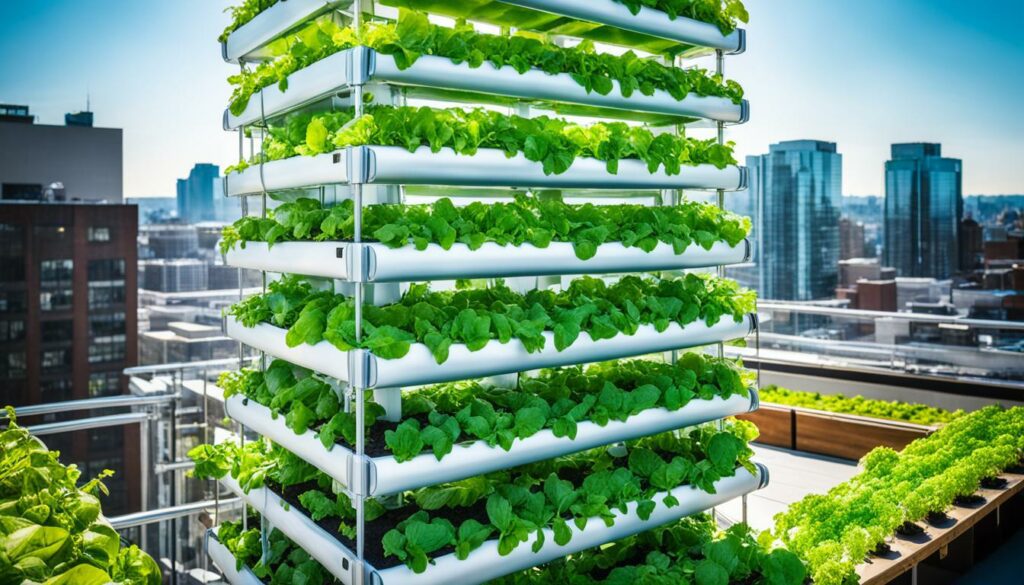
Hydroponics and aquaponics are also moving farming forward. Hydroponics grows plants in water rich with nutrients, needing less water and no soil. Aquaponics combines fish farming with plant growing. GrowUp Urban Farms does this to grow salads and fish in city spaces that were unused.
Bites and BitGrange are changing how city farming works. Bites helps people in Phoenix eat straight from the farm. BitGrange makes farming at home easy with little water and energy. They encourage eating local and teach about sustainable farming.
These new farming methods are at the heart of making city agriculture better. They make growing food in cities more efficient and introduce new, smart ways to feed our growing urban world.
Government backing is vital for urban farming to grow all across the country. The USDA, via its Office of Urban Agriculture and Innovative Production, has shown a strong dedication. Thanks to the 2018 Farm Bill, this office can give out lots of help and funds. It’s main goal is to support urban farming in America.
The USDA is making $4 million available in grants for projects in urban farming. These grants aim to make local food easier to get and to support the environment. This effort is big and will impact how cities approach farming greatly.
Anyone interested in these grants must apply through Grants.gov by midnight, July 30, 2021. There are different types of projects, from planning new farms to putting farming ideas into action. These funds can speed up the growth of city, indoor, and other types of farming.
Local governments are also getting in on the action, realising how vital urban farming is. They are starting their own projects to support farming in their cities. These projects encourage making community gardens and trying new farming indoors. They show that there’s political support for urban farming, helping to make good policies for it.
Plus, local support like AMS grants and FSA loans is also available. These help urban farmers even more, making it possible for them to succeed in today’s cities.
| Programme | Purpose | Funding | Deadline |
|---|---|---|---|
| USDA Grants | Support for urban agriculture and innovative production | Up to $4 million | July 30, 2021 |
| AMS Grants | Enhancing local food access and sustainability | Variable | Ongoing |
| FSA Loans | Financial aid for urban agriculture entities | Variable | Ongoing |
Community garden initiatives really make a difference in towns and cities. They help people feel like part of a community. These efforts also give folks the chance to eat fresh, healthy food. Huerto Tlatelolco in Mexico City is a great example of this.
Huerto Tlatelolco is special because it focuses on a type of gardening that saves space. It teaches people how to grow lots of plants even in the city. This garden is more than just a place to grow food. It’s a school for teaching green ways to live. This includes how to farm in a way that does not hurt the earth. Efforts like this one in Mexico City are helping people work together more, eat better, and feel closer to each other.
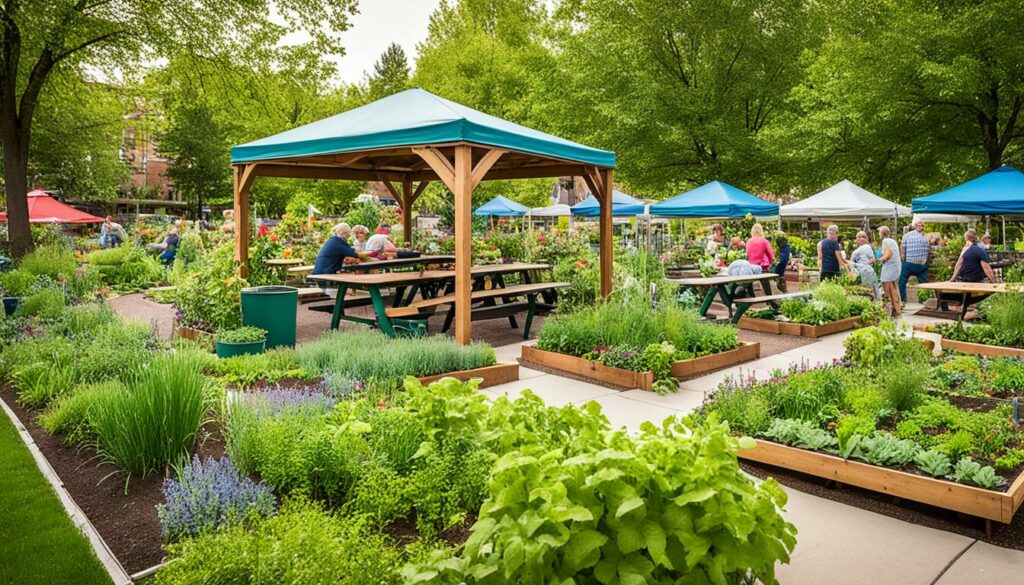
Projects like Huerto Tlatelolco depend a lot on people getting involved and learning about city farming. These gardens are not just for growing food. They are also places where people can learn in workshops and classes. These lessons are about how to take care of the earth, grow food, and eat in a way that is good for you.
People who help in these gardens are more likely to eat fruits and veggies. That’s because they see how good these foods are for them while gardening. By teaching people about where food comes from and how to grow it in the city, these gardens make both bodies and communities stronger.
| City | Key Initiative | Impact |
|---|---|---|
| Seattle | Code changes in 2010 | Promotion of urban agriculture and protection of farms |
| San Francisco | Salad Law (2012) | Permits urban agriculture city-wide |
| Federal Way | Regulation amendments (2013) | Supports the growing interest in urban farming |
Getting the local community involved in these gardens can help make sustainability a way of life. This means that future generations can keep enjoying the benefits of city farming.
Urban agriculture faces many challenges. One big issue is the lack of space in cities. This challenge leads to finding new ways, like using rooftops and growing up in vertical farms, to make the most of what space is available. In places like New York City, rooftop farms and gardens are flourishing, giving fresh food to locals.
In urban areas, there’s not much land for farming. Yet, cities are finding smart ways to use what space they do have. They create community gardens and farms that grow upwards in buildings. Singapore, for instance, has several farms that grow crops without soil but with water. This approach allows for year-round production, showing that thinking outside the box can help urban farming succeed.
Finances are a big issue for urban farming. Getting money and turning a profit are tough for these projects. However, they can be successful. The FAO says almost half of urban farming ventures turn out to be both profitable and sustainable. In places like Nairobi, small farmers overcome economic issues by selling local products and finding new ways to make money.
Rules and laws can also make it hard for urban farming to grow. Things like where you can farm and what you can grow are determined by these regulations. But, in pushing forward, solving these issues could lead to new and better ways of farming. In cities like Accra, Ghana, dealing with rules has brought about several creative solutions.
Yet, there’s hope for urban farming. With hard work and thinking differently, we can overcome these issues. Bringing people together, from government officials to community members, is key. It takes a team effort to beat the challenges and keep urban farming moving forward.
Using sustainable methods in city farming is key. It helps urban agriculture projects last. It also keeps them eco-friendly. This is done by saving resources and cutting waste.
Preserving water is a must for city farms. They can use technologies like aquaponics. This mixes fish farming with growing plants in water. It helps save water by creating a cycle between fish and plants.
City farms can power up with the sun and wind. Solar panels and wind turbines are getting more popular on these farms. This green energy helps the environment. It also gives the farms a reliable and affordable energy source.
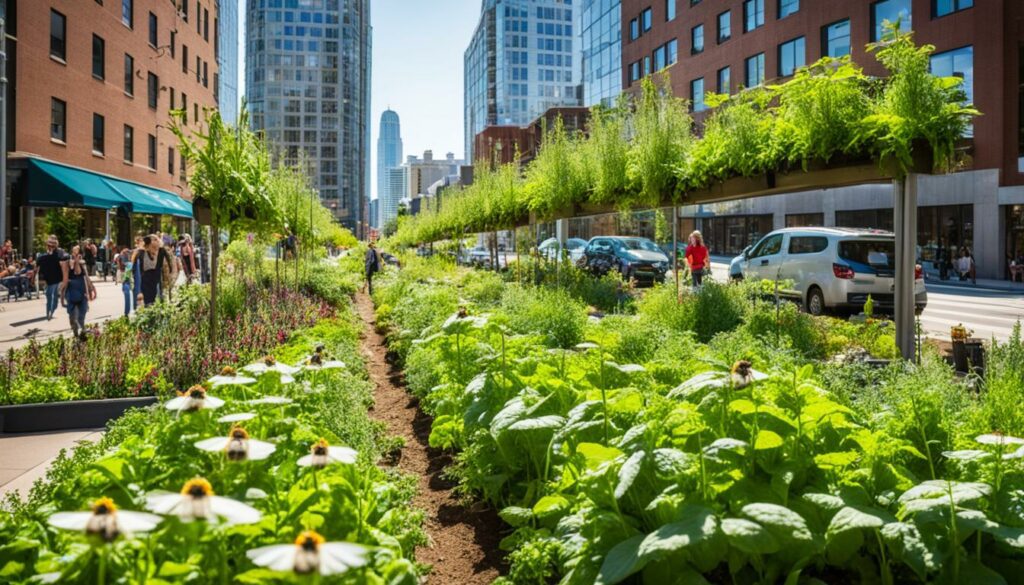
Reducing waste is crucial for city farms. They can turn food scraps and plant leftovers into compost. This improves the soil. They can also reuse materials, keeping things out of the landfill. These steps are vital for making city farming sustainable.
| Sustainable Practice | Implementation | Benefits |
|---|---|---|
| Water Conservation | Recycled irrigation, Aquaponics | Minimises water use, Promotes symbiotic cycles |
| Renewable Energy | Solar panels, Wind turbines | Reduces carbon footprint, Ensures economical energy |
| Waste Reduction | Composting, Material repurposing | Enriches soil, Reduces landfill waste |
The world’s population might hit 11 billion by 2100, with most people living in cities. This makes ensuring there’s enough food a big issue. Urban farming offers a way forward, using smart growing methods and making the most of what nature provides.
City farming plays a key part in making sure everyone has enough to eat by making access to fresh produce better. It fights against food deserts, where getting healthy food is tough. By growing food close to where it’s needed, there’s less need to bring it from far away. This means people in cities get food that’s both fresher and better for them.
Urban food deserts are places in cities where it’s hard to find cheap, good fresh food. Building farms in these spots helps by offering fresh fruits and vegetables right there. This not only helps with food worries but also brings communities together and teaches them about being eco-friendly.
| Challenges | Urban Agriculture Solutions |
|---|---|
| Food Deserts | Urban farms providing local fresh produce |
| Long-Distance Food Supply | Localised food production reducing transportation needs |
| Social Engagement | Community-focused urban agriculture projects |
By making city farming part of city plans, we can do more than just ensure there’s enough food. It also helps reach the UN’s global goals for a better world by 2030. As our cities change, backing and growing city farming will become more and more important.
The United Nations predicts nearly 6.68 billion people will live in cities by 2050. To feed them, urban farming has to become smarter. This means using tech like automation, robotics, and data to grow food better in cities.
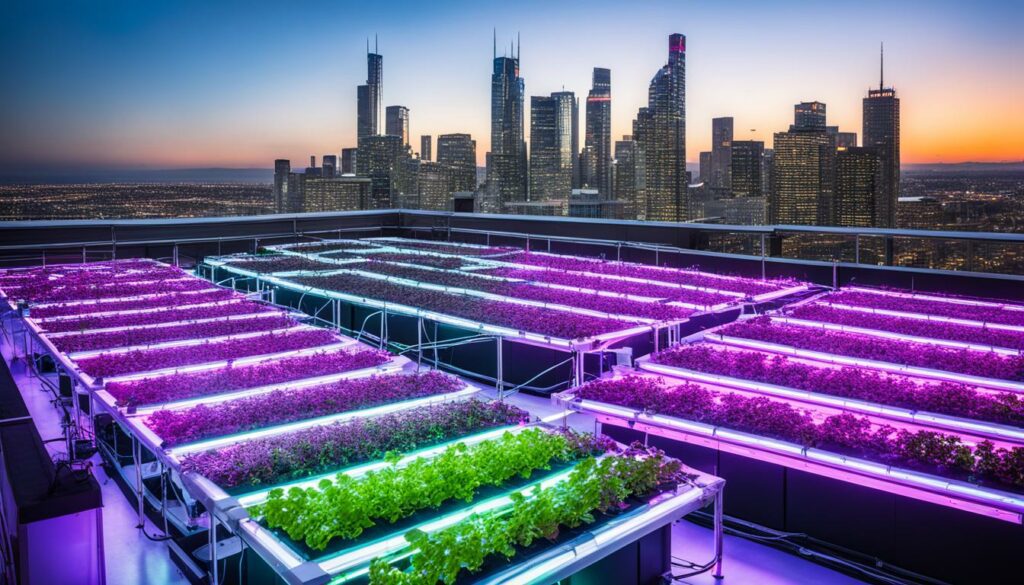
Technology is changing how we grow food in cities. Machines can now plant seeds and pick crops, making farming more precise and less dependent on people. For example, Bowery Farming grows leafy greens and herbs with less water and energy, thanks to robots. AeroFarms in Newark grows food using towers and needs 95% less water than traditional farms.
By gathering and analysing a lot of data, farmers can grow food more efficiently. They use tools like sensors, IOT, and special software to understand the needs of their plants better. Gotham Greens uses high-tech greenhouses to grow food with the help of renewable energy. BitGrange shows kids how to farm without using soil, teaching them to grow food in a smart and green way.
Adding technology to farming in cities makes better use of resources and brings more food. This is very important as more and more people live in urban areas. It helps fight against not having enough food to eat.
Getting educated and trained in urban agriculture is key. It blends practical skills with community focus. This happens in schools and beyond, helping people learn how to farm efficiently in cities.
Teaching urban farming in schools is important, especially to the young. The Winthrop Garden project is a good example. It has raised beds, a big greenhouse, and teaches about growing food.
Youth learn a lot from these farming programs. They understand how food is made and gets to our tables. Some even choose farming as a career, helping urban agriculture to grow.
Communities also get involved in farming through workshops. Programs, like those with A Just Harvest in Chicago, do more than just teach farming. They fight poverty and hunger, too.
Topics at these workshops include dealing with pests and plant diseases. They also focus on aquaponics, farming fish with plants. The Urban Agriculture program blends research and hands-on projects to deepen knowledge.
Working with the Food Recovery Network also shows how farming helps the community. It leads to things like food donations. These efforts strengthen urban agriculture and its link to the community.
Good urban agriculture policies are key for urban farming to grow. They provide the right setting for urban farming to do well. They help meet the needs of city life, like promoting local food in Europe. These policies are vital for funding and backing urban agriculture projects.
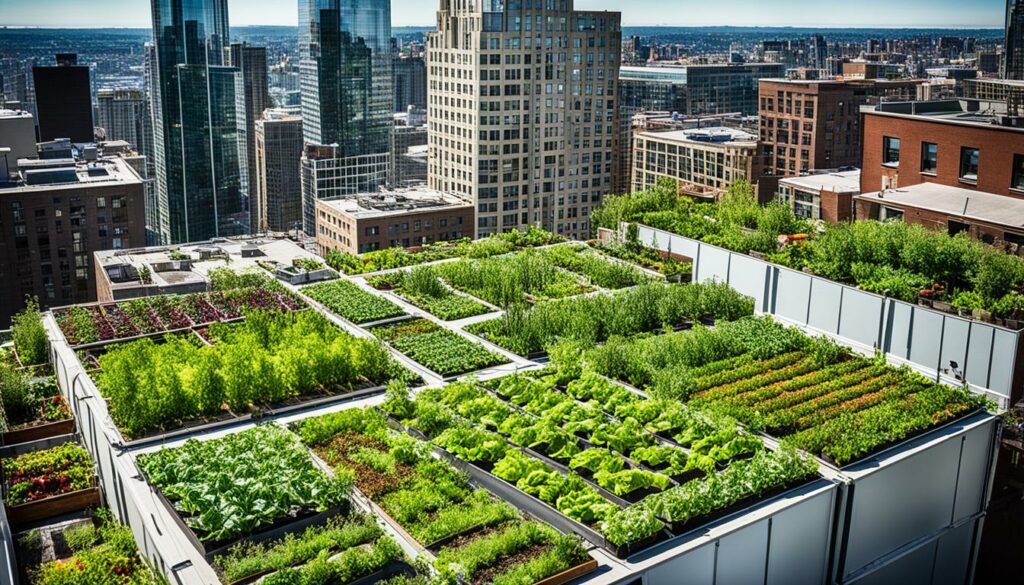
Changes in local policies are often the first rules that help urban farming. Yet, cities vary in how they support farming in their limits. For example, Lyon gives a lot of money for these projects. But, Barcelona doesn’t include urban agriculture in its use of new land. This shows we need a standard set of rules for urban farming. This way, all cities can benefit equally.
Big policies from nations and the EU shape urban farming much. The EU backing short food chains is a big move from 2014 to 2020. But, policies for urban farming are often spread across different areas. This includes land use and social projects to farming. Mixing local and EU efforts could offer a better plan for urban farming. It offers more support and helps big projects.
| City | Economic Backing | Land Use Inclusion | Support Level for Urban Agriculture Types |
|---|---|---|---|
| Lyon | Adequate | Limited | Favors allotment gardens |
| Barcelona | Insufficient | Excludes urban agriculture | Favors allotment gardens |
| Trieste | Insufficient | Limited | Favors allotment gardens |
| Udine | Insufficient | Limited | Favors allotment gardens |
Experts call for plans that put urban farming on the political map. This would help urban farming deal with big urban food, community, and green issues a lot better.
In today’s cities, partnerships urban agriculture play a crucial role. They help agriculture grow and stay in urban areas. These partnerships mix different resources and knowledge. They also get the community involved, making big steps in city farming.
Public and private groups working together boosts city farming. The government and private companies join forces. They start and grow projects that make more food. An example is the USDA’s $7.4 million into 25 city farming projects. These efforts also meet financial needs, ensuring the projects’ success.
For example, a 25% match is required in projects about composting and cutting food waste.
Working together with local communities is vital for city farming. The USDA sets up Urban Service Centers and joins with local groups in big cities like LA, NY, and Philadelphia. They invested $11.5 million in making compost and reducing food waste in 23 states. Projects in Boston, like GrowBoston, and in San Antonio show how local help can build sustainable food systems.
In summary, public-private collaborations and community-based support are key for urban farming. They bring together different help and achieve many benefits. This helps city farming projects last and succeed.
In the future, urban agriculture promises a lot, focusing on being green and new ideas. The Biden-Harris team is putting lots of money in this area. They want to make sure cities can grow their own food well, even with lots of people.
Urban farming is getting better with new tech and economic changes. The USDA, for instance, is spending over $11 million to help cut food waste in 23 states. It’s part of big steps towards using smart farming in cities.
The USDA and the Reinvestment Fund are putting nearly $23 million to make sure everyone can get healthy food easily. Such big investments show how serious we are about making better city food. They’re also starting new committees with $43 million to strengthen local food chains.
For urban farming to last, it needs money and study. The USDA is putting almost $7.5 million into 25 projects for lasting city farming. Also, the NIFA is giving over $9 million for research that supports these kinds of farms.
Starting in 2020, over $46 million went to 186 urban farming projects. Many different groups can get these grants, from local governments to schools. This will help urban farming not just grow food but also build strong communities.
Urban agriculture is about cultivating, processing, and distributing food in towns or the suburbs. It includes everything from small community gardens to high-tech farms indoors.
City farming is key. It helps with providing food, tackling climate change, bringing people together, helping the poor, and managing water better.
City farms boost our economies. They create jobs and help local areas grow economically.
Besides food, it fosters strong, active communities. It offers learning chances and helps people reconnect with the natural world.
These farms cut down on water use and bring more plants and animals to town. They also add green spaces to our city maps.
A few great examples are **AeroFarms** in Newark with its **aeroponics**, **Gotham Greens** in climate-controlled greenhouses, and **Agricool** in Paris, growing strawberries with **clean energy** in city containers.
There are cool tools like **vertical farming** and **aquaponics**. Plus, clever systems like **Bites** and **BitGrange** help people buy fresh produce and learn about farming.
The **USDA** is very involved. They offer **grants** and help groups work together. Their goal is to make sure we all have good food nearby.
Places like **Huerto Tlatelolco** in Mexico City do a lot. They teach about growing things and bring neighbourhoods closer. Everyone gets fresh food, which is a big deal.
There are a few hurdles. Space is tight in the city. It’s also tough to get funding. Plus, there are rules about where and how you can grow.
**City farming** is all about being smart with water, using green energy, and reusing waste well. These methods help the planet and make cities nicer.
It makes cities safer when it comes to food. There’s more fresh food nearby, which cuts down on long trips for food. Plus, there are healthier choices in parts of town where there wasn’t much before.
Tech makes farms better. It helps farmers do their job better, make more food, and use less water and energy.
This is really important. Schools and community classes teach people how to farm in the city. It’s skills everyone needs to know.
Rules at many levels help city farming happen. They make a space where urban farmers can do good work. The USDA is a big help in this area, too.
**Partnerships** are key. When different groups work together, they can do amazing things. They can get more done and help cities grow food better.
We’ll see better plants and farming tools made for the city. **Smart tech** and strong policies will make sure we can keep growing food in towns for a long time.